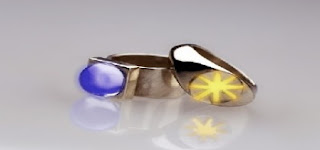Digital jewelry is the fashion jewelry with embedded intelligence. “Digital jewelry” can help you solve problems like forgotten passwords and security badges. “Digital jewelry” is a nascent catchphrase for wearable ID devices that contain personal information like passwords, identification, and account information. They have the potential to be all-in-one replacements for your driver's license, key chain, business cards, credit cards, health insurance card, corporate security badge, and loose cash. They can also solve a common dilemma of today's wired world – the forgotten password.
DIGITAL JEWELRY AND ITS COMPONENTS:
Soon, cell phones will take a totally new form, appearing to have no form at all. Instead of one single device, cell phones will be broken up into their basic components and packaged as various pieces of digital jewelry. Each piece of jewelry will contain a fraction of the components found in a conventional mobile phone. Together, the digital-jewelry cell phone should work just like a conventional cell phone.
The various components that are inside a cell phone :
Microphone, Receiver, Touch pad, Display, Circuit board, Antenna, and Battery .
IBM has developed a prototype of a cell phone that consists of several pieces of digital jewelry that will work together wirelessly, possibly with Blue tooth wireless technology, to perform the functions of the above components.
Cell phones may one day be comprised of digital accessories that
Work together through wireless connections.
Here are the pieces of computerized-jewelry phone and their functions:
• Earrings - Speakers embedded into these earrings will be the phone's receiver.
• Necklace - Users will talk into the necklace's embedded microphone .
• Ring - Perhaps the most interesting piece of the phone, this "magic decoder ring” is equipped with light-emitting diodes (LEDs) that flash to indicate an incoming call. It can also be programmed to flash different colors to identify a particular caller or indicate the importance of a call.
• Bracelet - Equipped with a video graphics array (VGA) display, this wrist display could also be used as a caller identifier that flashes the name and phone number of the caller.
With a jewelry phone, the keypad and dialing function could be integrated into the bracelet, or else dumped altogether -- it's likely that voice-recognition software will be used to make calls, a capability that is already commonplace in many of today's cell phones. Simply say the name of the person you want to call and the phone will dial that person. IBM is also working on a miniature rechargeable battery to power these components.
With a jewelry phone, the keypad and dialing function could be integrated into the bracelet, or else dumped altogether -- it's likely that voice-recognition software will be used to make calls, a capability that is already commonplace in many of today's cell phones. Simply say the name of the person you want to call and the phone will dial that person. IBM is also working on a miniature rechargeable battery to power these components.
The mouse-ring that IBM is developing will use the company's Track Point technology to wirelessly move the cursor on a computer-monitor display. (Track Point is the little button embedded in the keyboard of some laptops). IBM Researchers have transferred TrackPoint technology to a ring, which looks something like a black-pearl ring. On top of the ring is a little black ball that users will swivel to move the cursor, in the same way that the TrackPoint button on a laptop is used. This Track Point ring will be very valuable when monitors shrink to the size of watch face. In the coming age of ubiquitous computing, displays will no longer be tied to desktops or wall screens. Instead, you'll wear the display like a pair of sunglasses or a bracelet. Researchers are overcoming several obstacles facing these new wearable displays, the most important of which is the readability of information displayed on these tiny devices.
TECHNICAL SPECIFICATIONS OF DIGITAL JEWELRY:
Digital jewelry devices consist of a screen or display for information, most likely consisting of 7-16- segment, or dot matrix LEDs, LCDs, or other technologies such as electroluminescent material (EL) or others, which could become an optional display. So too, an audiovisual or other 'display' could consist of a speaker, a single flashing light, a sensor of some kind (such as a temperature driven EL display), or other informational aesthetic. The display layer sits on a face of the device, which is enclosed in some material such as plastic, metal, crystal, or other material. It has external switches and buttons on its side and a data-port for accessing the programmable electronic circuit inside. A micro controller that is a surface mounted device (SMD) on a printed circuit board (PCB) with resistors (R) and capacitors (C) are the internal 'guts' of the jewelry.







